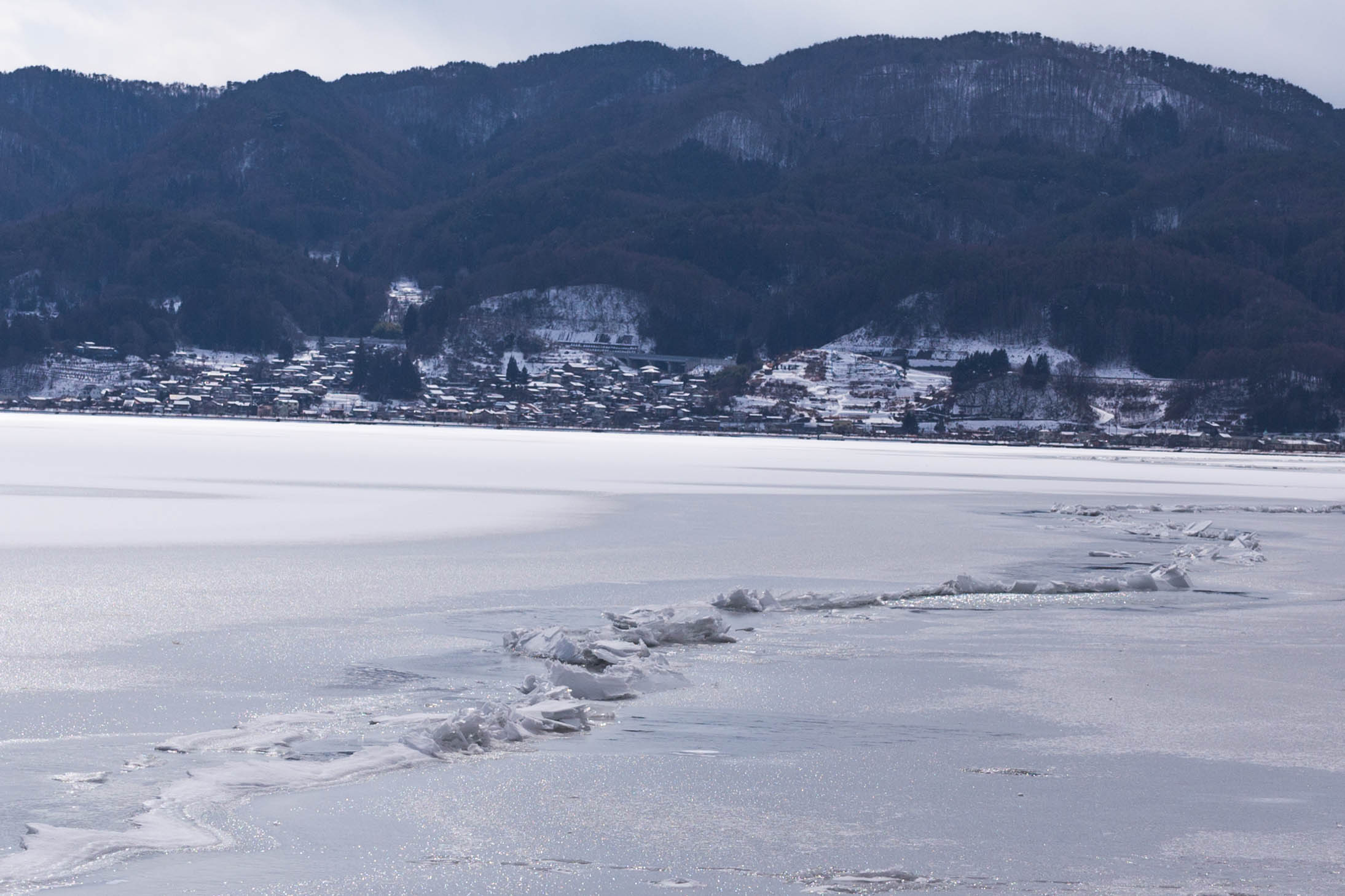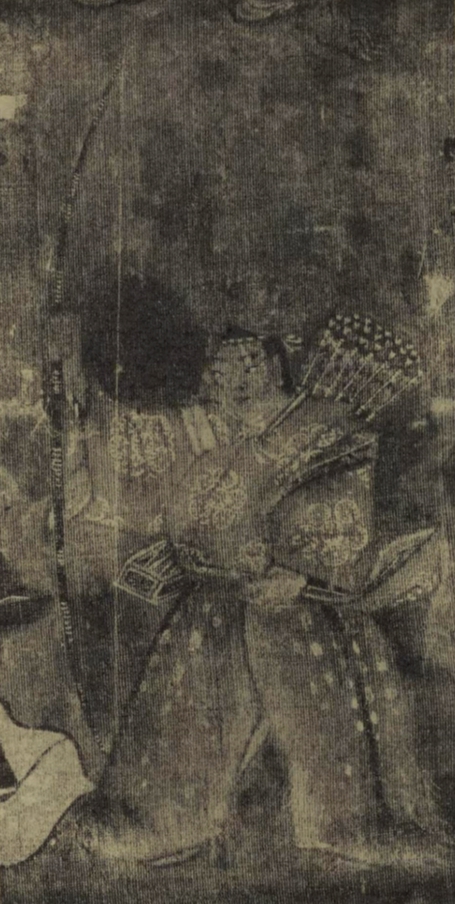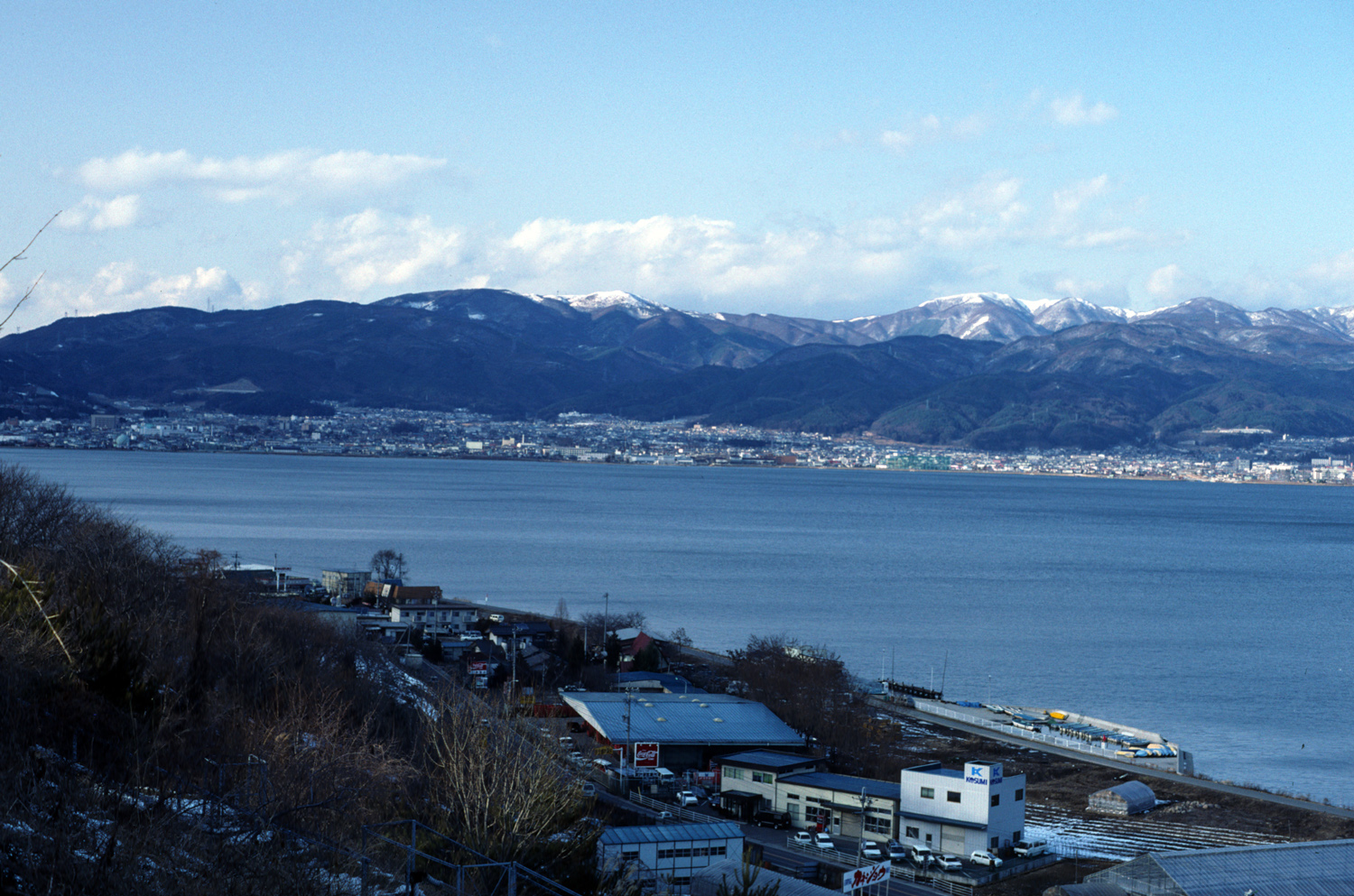|
Onbashira
The are four wooden posts or pillars that stand on the four corners of local shrines in the Lake Suwa area of Nagano Prefecture (historical Shinano Province), Japan. The largest and most famous set of are those that stand on the four shrines that make up the Suwa Grand Shrine complex. By custom, the are replaced every six ( traditionally reckoned as seven) years, in the years of the Monkey and the Tiger in the Chinese zodiac. In Suwa Shrine, this occurs during the , which also functions as a symbolic renewal of the shrine's buildings. During the festival, sixteen specially chosen fir trees are felled and then transported down a mountain, where they are then erected at the four corners of each shrine. Festival participants ride the as they are slid down the mountain, dragged to the shrine, and raised, and the festival has the reputation of being the most dangerous in Japan due to the number of people regularly injured or killed while riding the logs. This festival, which la ... [...More Info...] [...Related Items...] OR: [Wikipedia] [Google] [Baidu] |
Suwa Taisha
, historically also known as Suwa Shrine (諏訪神社 ''Suwa-jinja'') or , is a group of Shinto shrines in Nagano Prefecture, Japan. The shrine complex is the ''ichinomiya'' of former Shinano Province and is considered to be one of the oldest shrines in existence, being implied by the '' Nihon Shoki'' to already stand in the late 7th century. Kanpei-taisha Overview The entire Suwa shrine complex consists of four main shrines grouped into two sites: the Upper Shrine or ''Kamisha'' (上社), comprising the and the , and the Lower Shrine or ''Shimosha'' (下社), comprising the ''Harumiya'' (春宮, spring shrine) and the ''Akimiya'' (秋宮, autumn shrine). The Upper Shrine is located on the south side of Lake Suwa, in the cities of Chino and Suwa, while the Lower Shrine is on the northern side of the lake, in the town of Shimosuwa. In addition to these four main shrines, some sixty other auxiliary shrines scattered throughout the Lake Suwa area (ranging from miniature stone ... [...More Info...] [...Related Items...] OR: [Wikipedia] [Google] [Baidu] |
Takeminakata
Takeminakata (タケミナカタ), also known as Minakatatomi or Takeminakatatomi, is a ''kami'' in Japanese mythology. Also known as or after Suwa Grand Shrine (Suwa Taisha) in Nagano Prefecture (former Shinano Province) in which he is enshrined alongside his consort Yasakatome, Takeminakata is historically worshiped as a god of wind, water and agriculture, as well as a patron of hunting and warfare, in which capacity he enjoyed a particularly fervent cult from various samurai clans during the medieval period such as the Hōjō or the Takeda. Takeminakata was also held to be the mythical ancestor of certain families who once served at the shrine as priests, foremost among them being the Suwa clan, the high priests of the Upper Shrine of Suwa who were also revered as living vessels of the god. Whereas in the '' Kojiki'' (ca. 712 CE) and later derivative accounts, Takeminakata appears as one of the sons of the god Ōkuninushi who fled to Lake Suwa after being defeated by t ... [...More Info...] [...Related Items...] OR: [Wikipedia] [Google] [Baidu] |
Suwa, Nagano
is a city located in Nagano Prefecture, Japan. , the city had an estimated population of 48,972 in 20698 households, and a population density of 452 persons per km². The total area of the city is . History The shores of Lake Suwa have been inhabited since at least the Japanese Paleolithic period. The Suwa clan ruled the area since the Nara period, and the area developed as a castle town for Suwa Domain under the Edo period Tokugawa shogunate and as a post station on the Kōshū Kaidō highway. In the post-Meiji restoration cadastral reforms of April 1, 1889, the village of Kamisuwa was established. Kawasuwa was elevated to town status on April 20, 1891. After merger with the villages of Shiga and Toyoda (from Suwa District), Kamisuwa was elevated to city status on August 10, 1941, changing its name to Suwa. Geography Suwa is located in central Nagano Prefecture, bordered on the north and west by Lake Suwa, approximately 100 kilometers south of the prefectural capital of N ... [...More Info...] [...Related Items...] OR: [Wikipedia] [Google] [Baidu] |
Lake Suwa
is a lake in the Kiso Mountains, in the central region of Nagano Prefecture, Japan. Geography The lake is the source of the Tenryū River. It ranks 24th in lake water surface area in Japan. The cities of Suwa and Okaya and the town of Shimosuwa are located on the shores of Lake Suwa. Omiwatari Lake Suwa is the site of a natural phenomenon known as the , large cracks that form in the winter across the surface of the frozen lake. A vertical temperature gradient results in ice pressure ridges forming in the surface ice, reaching heights of or more. Local Shinto tradition holds that the ridges are formed by the gods crossing the lake when traveling between the various buildings of the Suwa Grand Shrine. Folklore says it is the guardian god of Suwa, Takeminakata-no-kami, leaving his sanctuary to meet with his wife, the goddess , joining the opposite bank by walking on frozen water. The record of this crossing is the oldest-known human-observed climate record. This record has ... [...More Info...] [...Related Items...] OR: [Wikipedia] [Google] [Baidu] |
Suwa Clan
The , also known as the Jin or Miwa clan (神氏, ''Miwa uji / Miwa-shi'' or ''Jinshi'') was a Japanese '' shake'' and samurai family. Originating from the area encompassing Lake Suwa in Shinano Province (modern-day Nagano Prefecture), it was originally a family of priests who served at the Upper Shrine of Suwa located on the southwestern side of the lake. By the Kamakura period, it thrived as a prominent samurai clan with close ties to the shogunate. Surviving the fall of both the Kamakura shogunate and the Southern Imperial Court which it supported, its feud with local rival clans, and frequent clashes with its neighbor in Kai, the Takeda clan, during the Sengoku period (which ended in the extinction of the main family), by the Edo period the clan had split into two branches: one ruling the Suwa Domain of Shinano as ''daimyō'', with the other continuing to serve as priests of Suwa Shrine until the Meiji period. Ancestry In legend Although the Suwa, which was the high p ... [...More Info...] [...Related Items...] OR: [Wikipedia] [Google] [Baidu] |
Okaya, Nagano
is a city located in Nagano Prefecture, Japan. , the city had an estimated population of 48,616 in 19,257 households, and a population density of 570 persons per km². The total area of the city is . Geography Okaya is located in central Nagano Prefecture at the western shores of Lake Suwa and the headwaters of the Tenryū River. Surrounding municipalities *Nagano Prefecture ** Matsumoto ** Shiojiri ** Suwa ** Shimosuwa ** Tatsuno Climate The city has a climate characterized by characterized by hot and humid summers, and relatively mild winters (Köppen climate classification ''Cfa''). The average annual temperature in Okaya is 10.6 °C. The average annual rainfall is 1281 mm with September as the wettest month. The temperatures are highest on average in August, at around 23.6 °C, and lowest in January, at around -1.9 °C. Demographics Per Japanese census data, the population of Okaya has declined over the past 50 years. History The area of presen ... [...More Info...] [...Related Items...] OR: [Wikipedia] [Google] [Baidu] |
Nagano Prefecture
is a landlocked prefecture of Japan located in the Chūbu region of Honshū. Nagano Prefecture has a population of 2,052,493 () and has a geographic area of . Nagano Prefecture borders Niigata Prefecture to the north, Gunma Prefecture to the northeast, Saitama Prefecture to the east, Yamanashi Prefecture to the southeast, Shizuoka Prefecture and Aichi Prefecture to the south, and Gifu Prefecture and Toyama Prefecture to the west. Nagano is the capital and largest city of Nagano Prefecture, with other major cities including Matsumoto, Ueda, and Iida. Nagano Prefecture has impressive highland areas of the Japanese Alps, including most of the Hida Mountains, Kiso Mountains, and Akaishi Mountains which extend into the neighbouring prefectures. The abundance of mountain ranges, natural scenic beauty, and rich history has gained Nagano Prefecture international recognition as a world-class winter sports tourist destination, including hosting the 1998 Winter Olympics and a new ... [...More Info...] [...Related Items...] OR: [Wikipedia] [Google] [Baidu] |
Shimosuwa, Nagano
is a Towns of Japan, town located in Nagano Prefecture, Japan. , the town had an estimated population of 20,055 in 8864 households, and a population density of 300 persons per km². The total area of the town is . Geography Shimosuwa is located in central Nagano Prefecture, approximately 50 kilometers from the prefectural capital of Nagano city and 200 kilometers from Tokyo. The town is bordered on the south by Lake Suwa. The town has an altitude of 760 meters at the town center, and is 82% forested. Surrounding municipalities *Nagano Prefecture ** Matsumoto, Nagano, Matsumoto ** Suwa, Nagano, Suwa ** Okaya, Nagano, Okaya ** Nagawa, Nagano, Nagawa Climate The town has a humid continental climate characterized by warm and humid summers, and cold winters (Köppen climate classification ''Dfb''). The average annual temperature in Shimosuwa is 7.3 °C. The average annual rainfall is 1540 mm with September as the wettest month. The temperatures are highest on average in A ... [...More Info...] [...Related Items...] OR: [Wikipedia] [Google] [Baidu] |
Honden
In Shinto shrine architecture, the , also called , or sometimes as in Ise Shrine's case, is the most sacred building at a Shinto shrine, intended purely for the use of the enshrined ''kami'', usually symbolized by a mirror or sometimes by a statue.JAANUS The building is normally in the rear of the shrine and closed to the general public. In front of it usually stands the ''Haiden (Shinto), haiden'', or Public speaking, oratory. The ''haiden'' is often connected to the ''honden'' by a ''Heiden (Shinto), heiden'', or hall of offerings. Physically, the ''honden'' is the heart of the shrine complex, connected to the rest of the shrine but usually raised above it, and protected from public access by a fence called ''tamagaki''. It usually is relatively small and with a gabled roof. Its doors are usually kept closed, except at matsuri, religious festivals. Kannushi, Shinto priests themselves enter only to perform rituals. The rite of opening those doors is itself an important part of ... [...More Info...] [...Related Items...] OR: [Wikipedia] [Google] [Baidu] |
Samurai
were the hereditary military nobility and officer caste of medieval and early-modern Japan from the late 12th century until their abolition in 1876. They were the well-paid retainers of the '' daimyo'' (the great feudal landholders). They had high prestige and special privileges such as wearing two swords and ''Kiri-sute gomen'' (right to kill anyone of a lower class in certain situations). They cultivated the '' bushido'' codes of martial virtues, indifference to pain, and unflinching loyalty, engaging in many local battles. Though they had predecessors in earlier military and administrative officers, the samurai truly emerged during the Kamakura shogunate, ruling from 1185 to 1333. They became the ruling political class, with significant power but also significant responsibility. During the 13th century, the samurai proved themselves as adept warriors against the invading Mongols. During the peaceful Edo period (1603 to 1868), they became the stewards and chamberlains of ... [...More Info...] [...Related Items...] OR: [Wikipedia] [Google] [Baidu] |
List Of War Deities
A war god in mythology associated with war, combat, or bloodshed. They occur commonly in both monotheistic and polytheistic religions. Unlike most gods and goddesses in polytheistic religions, monotheistic deities have traditionally been portrayed in their mythologies as commanding war in order to spread religion. (The intimate connection between "holy war" and the "one true god" belief of monotheism has been noted by many scholars, including Jonathan Kirsch in his book ''God Against The Gods: The History of the War Between Monotheism and Polytheism'' and Joseph Campbell in ''The Masks of God, Vol. 3: Occidental Mythology''.) The following is a list of war deities: North Africa Egyptian *Anhur, god of war, not a native god * Bast, cat-headed goddess associated with war, protection of Lower Egypt and the pharaoh, the sun, perfumes, ointments, and embalming *Horus, god of the king, the sky, war, and protection *Maahes, lion-headed god of war *Menhit, goddess of war, "she wh ... [...More Info...] [...Related Items...] OR: [Wikipedia] [Google] [Baidu] |







.jpg)

